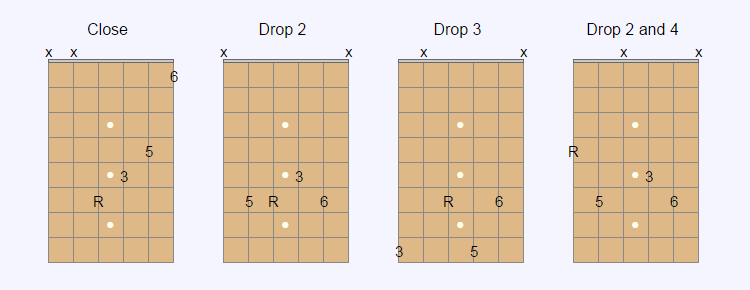The following diagrams show commonly used chord voicings, using an A♭6 chord as shown on the staff.


Close voicings arrange all the notes of the chord as closely together as possible. Close voicings can be difficult or impossible to finger conventionally on guitar, so are often converted to more playable drop voicings.
Drop 2 voicings take the 2nd note from the top of a close voicing and move it down one octave. On guitar, the notes are then generally played on adjacent strings.
Drop 3 voicings take the 3nd note from the top of a close voicing and move it down one octave. On guitar, this usually results in an unused string between the two lowest notes.
Drop 2 and 4 voicings take the 2nd and 4nd note from the top of a close voicing and move them down one octave. On guitar, this usually results in an unused string between the two middle notes.
This tutor shows drop 2 and drop 3 voicings. For drop 2 and 4 voicings see the Chord Voicing Tutor.
The rooted voicing pages show drop 2 and drop 3 voicings with user control of the voicing shown. Each major rooted voicing page shows the IIm7, V7 and the tritone substitute ♭II7, and the Imaj7 and I6 chords. The major rooted voicing pages also allow selection of the equivalent IIm11 or V7sus (V11) chords. For Imaj7 chords where the 7 and R make minor 2nd or minor 9th intervals, the 9 is shown replacing the R (R shown in light gray). Each minor rooted voicing page shows the IIm7♭5, V7♭9 and the tritone substitute ♭II7♭9, and the Im7 and Im69 chords. Each rooted chord has four voicings.
The rootless voicing pages show drop 2, drop 3 and close voicings with user control of the voicing shown as well as user control of the dominant chord type shown. Each major rootless voicing page shows the IIm9, V13 or V7alt and the tritone substitute ♭II, and the Imaj9 and I69 chords. The major rootless voicing pages also allow selection of V9sus (equialent to IIm7) or V13sus (equivalent to IIm9) chords. Each minor rootless voicing page shows the IIm7♭5 (rooted), V7alt and the tritone substitute ♭II, and the Im7 and Im69 chords.
As is common in rootless voicings, the rootless drop 2 chords have two voicings with ♭3 and ♭7 as the lowest note of the IIm9. The rootless drop 2 voicings on string group 4321 also show the voicing with 5 as the lowest note of the IIm9. The rootless drop 3 chords have two voicings with 5 and ♭7 as the lowest note of the IIm9.
Each rooted and rootless voicing page has Previous and Next buttons that control the voicing shown. The default rooted voicing has the root as the lowest note. The default rootless voicing has ♭3 as the lowest note. The voicing displayed will continue to be shown on subsequent pages where possible.
The rootless pages convert a previous voicing with the root as the lowest note to the voicing with ♭3 as the lowest note. The rootless drop 2 pages except for string group 4321 convert a previous voicing with 5 as the lowest note to the voicing with ♭7 as the lowest note. The rootless drop 3 pages convert a previous voicing with ♭7 as the lowest note to the voicing with 5 as the lowest note.
Each major rootless voicing page has nine buttons that change the dominant chord type as indicated. The default major rootless dominant chord type shown is V13. Each minor rootless voicing page has four buttons that change the dominant chord type as indicated. The default minor rootless dominant chord type shown is V7♯5♯9. The dominant chord type and voicing displayed will continue to be shown on subsequent rootless voicing pages if possible. The rooted voicing pages and this page reset the rootless dominant chord type back to the original default. This page also resets the voicing to the rooted and rootless defaults.
The major voicings are shown in the key of C Major and the minor voicings are shown in C Minor. The rootless voicings especially sound best when played within a certain range (this applies to the piano also). Voicings shown at the lower part of the guitar's range that sound muddy will sound nice when played higher in other keys. Not all of the close voicings are playable using conventional fingering on guitar but they clearly show how the voices typically move through subdominant to dominant to tonic chords. The close voicings also sound nice as three-note chords using the upper or lower three notes.
Each rootless major and minor voicing type has an associated equivalence link (~). These pages show additional rooted or rootless chords that result from assigning a new root to a previous voicing. For the major rootless voicings, the previous voicing is the V13. For the minor rootless voicings, the previous voicing is the Im69.
Rootless drop 3 dominant ♯9 voicings produce minor 9th and upper voice minor 2nd intervals which can sound harsh and are difficult to finger. Rootless drop 2 dominant ♯9 voicings with ♯9 as the lowest note also produce minor 9th intervals. Where a minor 9th interval occurred between the ♯9 and the 3 those voices were switched. Where a minor 2nd occurred between the ♯9 and the 3 in the top voices the 3 was dropped an octave. These modifications result in drop 2 voicings. An alternate fingering for the top voice is shown in gray which keeps the note on the same string as the other drop 3 fingerings (these are unusual but I especially like when fingerpicking).
Special thanks to Gerhard Ersdal for additional rootless voicing contributions.
Have fun, and contact me with questions, suggestions or problems.